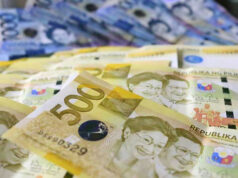Yields on gov’t debt drop on inflation, GDP data
YIELDS ON government securities (GS) fell last week following lower April inflation as well as the contraction of the Philippine economy in the first quarter to its worst performance in more than 20 years.
Debt yields, which move opposite to prices, declined 15 basis points (bps) on average week on week, according to the PHP Bloomberg Valuation Service Reference Rates of May 8 published on the Philippine Dealing System’s website.
At the secondary market last Friday, yields were lower than week-ago levels across all tenors, except for 25-year papers which inched up 9 bps to 4.555%.
The 91-day Treasury bill went down 27.5 bps to yield 2.699%. The 182- and 364-day papers likewise declined 29.1 bps and 13.1 bps, respectively, to fetch 2.773% and 2.879%.
At the belly, rates of two-, three-, and four-year bonds went down 15.8 bps (2.919%), 17.9 bps (2.980%), and 19.1 bps (3.045%), respectively. Yields on the five- and seven-year papers likewise dropped 19.3 bps (3.112%) and 16.4 bps (3.249%).
At the long end of the yield curve, rates on the 10- and 20-year notes decreased 14 bps and 2.1 bps, respectively, to 3.350% and 4.300%.
“Local yields fell due to some safe-haven demand ahead of the Philippine inflation and economic growth reports. Later [last] week, these data turned out to be weaker readings which pulled yields further,” a bond trader said in an e-mail last week.
In a separate e-mail interview, Security Bank Corp. First Vice-President and Head of Institutional Sales Carlyn Therese X. Dulay said GS yields continued to move lower last week on “strong buying interest from clients and market participants and on expectations of more rate cuts by the Bangko Sentral ng Pilipinas (BSP).”
She also added that the first-quarter gross domestic product (GDP) results “put a slight damper on the rally” last week.
On March 5, the Philippine Statistics Authority (PSA) reported April inflation eased to a five-month low of 2.2%, slower than 2.5% annual rate in March, and three percent in April 2019.
The April reading was slower than the 2.1% median estimate in a BusinessWorld poll of 13 economists conducted last week but still within the 1.9%-2.7% forecast range given by the BSP Department of Economic Research for the month.
Year to date, inflation settled at 2.6%, still within the central bank’s 2%-4% target band and above the revised two-percent forecast for the entire 2020.
The central bank already cut benchmark rates thrice this year — a 25-bp cut in February followed by 50-bp reductions in March and April — now ranging from 2.25% to 3.25%.
Last Thursday, BSP Governor Benjamin E. Diokno said this 125-bp cumulative cut to interest rates is “appropriate” to cushion the country’s growth momentum and boost market confidence to weather strong headwinds.
The central bank chief has said they will assess banks’ response to the policy moves as well as regulatory relief measures at the Monetary Board’s (MB) next meeting on June 25.
The MB has called off its May 21 meeting following the off-cycle 50-bp cut on April 16.
The PSA reported last Thursday the Philippine economy snapped its 84 quarters of uninterrupted growth after the gross domestic product (GDP) contracted 0.2% during the first three months of the year.
The last time GDP fell into negative territory was in the fourth quarter of 1998, when the economy shrank three percent at the height of the Asian financial crisis.
The first-quarter result was a reversal from the 6.7% and 5.7% growth recorded in the previous quarter and in the first three months of 2019, respectively. This also came unexpectedly lower than BusinessWorld median consensus of 2.9% growth for that period.
However, this was still within the Cabinet-level Development Budget Coordination Committee’s projection last month that the economy could contract by 0.8% or post zero growth this year.
“The weak economic imprint for the first quarter of 2020 might increase expectations of easing actions from the BSP either in the lowering of the policy rate or the reserve requirement ratio, both of which will cause local yields to drop,” the bond trader said.
Moreover, the bond trader expects that there could be some “safe-haven demand” amid uncertainty over possible government quarantine policies beyond May 15.
Meanwhile, Ms. Dulay said the recent outlook downgrade from Fitch Ratings may cause yields to move sideways to slightly higher this week.
Less than three months since it gave a “positive” outlook, debt watcher Fitch downgraded last Thursday the country’s sovereign rating outlook to “stable” as the economy faces a recession due to coronavirus disease 2019 pandemic.
Meanwhile, it maintained the country’s credit rating at “BBB” – a notch above the minimum investment grade which it gave in December 2017.
“The latest move by Fitch Ratings essentially minimized our prospects of a near-term credit upgrade to an ‘A’ level,” the bond trader said, adding that this development “might put some upward pressure on local yields, however, broad market expectations of monetary easing from the BSP in the future might offset this bias.” — Jobo E. Hernandez



